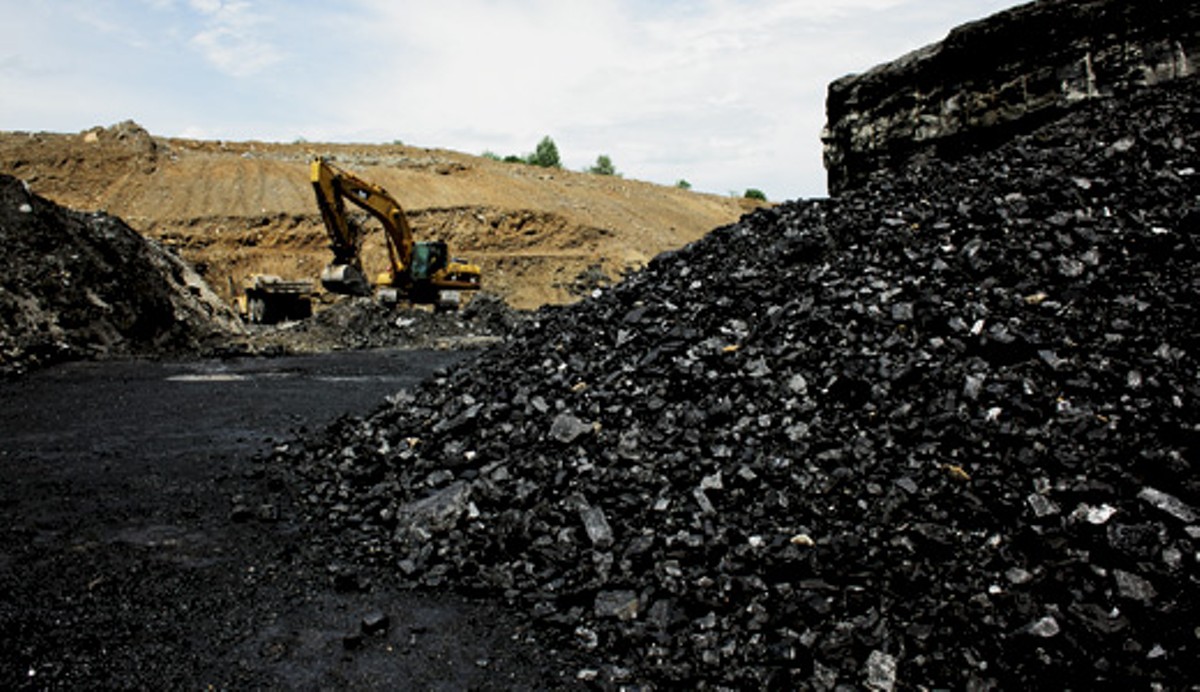Jim Gray, the mayor of Lexington, can barely contain his smile. “This is a big day,” he says, his voice shaking with excitement. “This is a big day for Lexington. This is a big day for Big Blue … Just a big day for our state.”
The big news is that the Los Angeles architectural group NBBJ will redesign Rupp Arena and the downtown Lexington convention center. “We will free Rupp Arena and reinvent it.” This press conference, which includes Gov. Steve Beshear, is meant to celebrate the upcoming renovation. According to Mayor Gray, this project “will connect Lexington’s urban core to our world-class rural landscape.”
This press conference comes on the heels of the revelation that $2.5 million of the Rupp Arena money will come from the coal severance tax — money coal companies have to pay to coal-producing counties as compensation for the resources they extract. When The Lexington Herald-Leader reported the story, they quoted House Speaker Greg Stumbo as saying, “Though Rupp is not in the coalfields, many believe it plays an important role in the state because of the tradition of the University of Kentucky basketball program, and there is strong alumni support in our region as well.”
Coal companies pay that tax because coal is not renewable: Once it is taken, its value is gone forever. That makes coal severance money extra valuable. Many find it unfair that the poorest counties in the state will have to use that money to fund Lexington’s downtown project.
At the press conference, Gov. Beshear didn’t address the controversy directly, but he suggested what benefited Lexington benefited the entire commonwealth. “Strengthening this city strengthens this state,” he said. “Lexington is one of the state’s economic engines. Together we can put this engine to a higher gear.”
Ultimately, however, this story isn’t just about Rupp Arena. Two-and-a-half-million dollars is pocket change compared to what the renovation will cost. What’s more interesting is the debate that has followed. It shows that no matter how often we address this issue, we are operating on outdated assumptions about coal, about poverty and about the future of rural Kentucky. Right now, there are billions of dollars that the coal companies have paid that could be used to help poor counties and hire laid-off miners. The bulk of that money is simply not being spent. The problem isn’t that some of that money goes to Rupp Arena; it’s that so little of that money goes to where it is supposed to go.
After the press conference, LEO Weekly asked Gov. Beshear if the state still planned to use coal severance tax to pay for the Rupp Arena renovation. “No,” he said, “not to my knowledge.” When asked the question a second time, the governor shook his head. “No, no, no,” he said. “Not anymore.”
LEO then asked, “Do you mean no money aside from what’s already reported?”
“Right,” he said. “No more money than the $2.5 million.”
When asked a follow-up, the governor said he’d have his energy secretary get in touch. Then he nodded and left without taking the reporter’s name or contact information. A follow-up call to Energy Secretary Len Peters went unreturned.
Matt Jones — host of the morning call-in show “Kentucky Sports Radio,” founder of the website of the same name, and arguably the state’s biggest UK fan — expresses disappointment that coal money is going to Rupp. “The symbolism of it really irks me,” he says. “Every time coal is mined, something is lost in Eastern Kentucky. What’s taken from this area cannot be replaced.”
Though Jones is a proponent of the renovation project, he feels there are better ways to fund it. “If you don’t think the (coal severance) money should go to Eastern Kentucky, then why have a tax on it at all?”
Jones, originally from Middlesboro, took personal umbrage at Stumbo’s statement that Eastern Kentuckians benefit from the renovation because they are UK fans. “I like Stumbo, but it offends me that he, as an East Kentuckian, thinks because we like basketball, we’d be OK with this … People in Eastern Kentucky love UK? Sure. People in Central Kentucky love UK, too. Let them pay for it.”
Jones disputes the often-heard complaint that Lexington and Louisville support poorer counties through their taxes, so those counties can support the cities with their coal. “That’s a tax on income, which goes to various funds across the state,” he says. “That’s why you live in a state. This money exists for a particular reason. If you get past helping East Kentucky, then why do it?”
Stumbo tells LEO that the story in The Lexington Herald-Leader was written by a reporter “who didn’t want to hear the rest of what I had to say.” He says the $2.5 million is part of a deal that would bring back more money to coal counties. House Bill 499, passed last year, restores $19 million — money Gov. Paul Patton transferred from coal severance taxes to a workers’ compensation fund — to coal counties “where it belongs.” “Any way you look at it, we’re bringing in more money than we’re sending out,” Stumbo says.
The biggest myth about the coal economy in Eastern Kentucky is that there is a coal economy in Eastern Kentucky. There are roughly the same amount of working coal miners in Appalachian Kentucky (9,500) as there are disabled citizens in Pike County (9,200). There used to be a coal economy, but now “coal” is more of a culture than a job-provider. The amount of coal mined and the amount of coal jobs are evaporating at an alarming rate. Coal mining in central Appalachia peaked in 1990 and has declined at an exceptionally high rate ever since. Kentucky’s coal-producing Fifth District is the poorest congressional district in the nation, and its residents have the lowest life expectancy and, according to a Gallup poll, the lowest “state of physical, mental and social well-being.” Any honest discussion of the Kentucky economy has to start with the fact that what the area is doing right now isn’t working.
Yet many Kentucky politicians continue to say, “Coal is our future.” They blame the job losses on environmental restrictions and imply that if the EPA would “get off our backs” — to use Gov. Beshear’s phrase — then the coal jobs would reappear. In spite of warning after warning from scientists, economists and concerned citizens, they resist the call to transition to a post-coal economy.
“I would tell those people to face reality,” says Evan Hansen of Downstream Strategies, an environmental consulting group based in Morgantown, W.Va. They predict a mammoth decline in Appalachian coal production over the next few decades, with the most precipitous drop coming in the next few years. “So long as politicians have decided that they will fight reality and not come to the table, they are losing out on opportunities,” he says. “Instead, they’ve decided to act like it’s not happening.”
“Eastern Kentucky should have been transitioning away from a coal economy long before now,” agrees Stumbo. “Everyone knows coal has a finite life.”
Stumbo believes the future is investing the same money in higher education. “Until the state recognizes the need for a public four-year college, there’s not going to be a bright future (in Eastern Kentucky). We send as many students to college as the rest of the state, but there’s nowhere to finish.”
He says college is a way of keeping young talent in the area and calls out the regional colleges, like Pikeville and Alice Lloyd, that have come up short. “We were supposed to be serviced by the regional universities, but that just didn’t happen. If you look at it, they didn’t meet their challenge.”
Coal has been a part of Appalachia for so long that many citizens never thought they’d have to prepare for any alternative.
“Coal has historically operated on a boom-and-bust cycle, so it’s not hard to understand why some folks might think, ‘If we just wait it out, the boom will come again,’” says Carrie Ray, research and policy associate of the Mountain Association for Community Economic Development (MACED). “But all signs indicate that this next boom isn’t coming — even our state secretary of energy agrees.”
She stresses the need for urgency. “With the coal industry in significant decline in the region, severance money is not going to be around forever, so we need to be planning for the future. Well, we needed to be planning for the future 20 years ago, but we absolutely can’t wait any longer. Severance funds are a significant source of resources that are intended for economic development and diversification in the coalfields. We just aren’t spending them that way.”
“I don’t know what the future of Eastern Kentucky holds,” says Matt Jones. “But it doesn’t take a rocket scientist to know we have to diversify the economy.”
Though Jones identifies himself as a liberal, he gets frustrated with other liberals who dismiss coal and coal-culture out of hand. “Whatever you think about coal, whatever side of the aisle you’re sitting on, you have to find the individuals who work in coal day-to-day something. You can’t just replace the economy without having something to replace it with.”
Interestingly enough, right now there is up to $2.5 billion of federal money that could not only kick-start this transition, but also provide work for many of the thousands of miners who have been laid off over the past 18 months. The money comes from the Abandoned Mine Lands Fund, which coal companies pay to reclaim abandoned strip mines. “Reclaim,” in this context, means to refurbish and reforest the land, getting it as close as possible to its natural state before the land was mined. The problem is the money is simply not being spent.
“It’s almost impossible for anyone in Eastern Kentucky to get their hands on that money,” says Stumbo. “Congress has kept that money bottled up for 30 years. It’s the hardest money to access … If I knew the answer to (why), I’d probably be the smartest man in America.”
Stumbo points out that the jobs theoretically created by reclamation are jobs miners are uniquely qualified to do. “Most miners can do darn near anything,” he says. “They have to run equipment. They have a great skill-set.”
It’s a point echoed by Carrie Ray of MACED. “Reclamation … has the potential to be a big job creator, and one that can employ former miners who know how to operate the heavy machinery required to break up the compacted soil, regrade, etc.” Outside of the environmental and health benefits of such a cleanup, she says the short-term economic benefits are substantial. “The best use of AML funds would be to put Appalachians back to work on these reclamation jobs.”
Although AML funds have to focus on reclaiming old sites, the coal severance tax is more flexible. Ray sees great opportunity here. “Miners have skills that can be used in other industries, whether it’s the electrician who gets trained to install energy-efficient lighting or the dozer operator who can operate the heavy machinery needed to replant forests on abandoned mine sites. The key is to provide meaningful work. A person who’s a coal miner because it’s ‘in his blood,’ so to speak, is not going to be fulfilled answering phones at a call center for $10 an hour.”
She fears the funds won’t be spent this way. Her worst-case scenario is that “the money continues to be spent on one-off projects or to fill budget gaps, and in 20 years, we find we barely have the money to do even that anymore, much less make the huge investments we need to bring the Appalachian economy around.”
Ultimately, the Rupp Arena renovation may be a “one-off project,” or it may allow the “economic engine” of Lexington to shift to a higher gear. Either way, a region in Kentucky is still the absolute poorest part of America. Resources exist to help it transition into a healthy, sustainable economy. No one denies there’s a need for jobs, no one denies there is local talent, and most agree that Appalachian coal has helped build the nation. Now people have to decide if Appalachia is worth renovating.
Why Wyoming?
The coal economy is still booming in Wyoming, where the coal is plentiful and relatively easy to mine. Nevertheless, Wyoming still receives money from the Abandoned Mine Lands Fund despite there being no abandoned mine lands. In 2012, for instance, the state of Wyoming received more than $150 million in AML money. This has led many in Appalachia to wonder why money to reclaim abandoned mine lands is going to places that don’t have that problem.
“So much of the mining happens out West because so little mining is happening now in the Appalachian region,” says Jason Bailey, director of the Kentucky Center for Economic Policy. “The formula, however, does not allocate the monies based on the need. Most of the need is here. It’s in the Appalachian region.”
Wyoming used the money on schools, for conservation and to secure their economic infrastructure. While those are laudable causes, some claim the money could be better used to fulfill a more direct economic need — putting laid-off miners back to work.
From 1972 to 1992, only 7.6 percent of the coal severance tax went back to coal counties.






